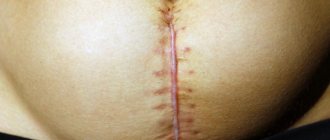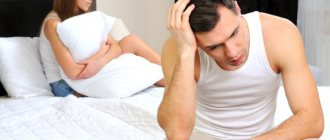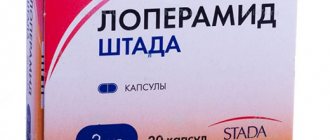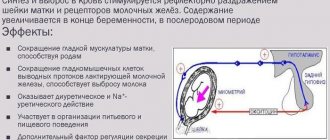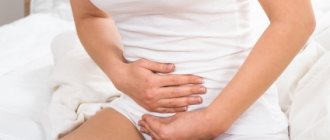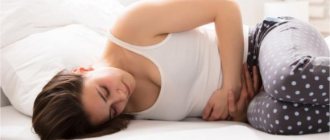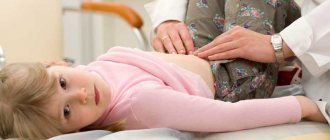Colonoscopy is, in principle, well tolerated by patients and is not considered traumatic, but in some cases the examination cannot be done. It is necessary to know about this, and after the procedure it is necessary to take restorative measures. It is important to be able to distinguish residual pain from dangerous clinical manifestations in order to consult a doctor in time.
Description of the procedure and features of preparation for colonoscopy
Colonoscopy is an examination of the inside of the entire colon, which includes the rectum, sigmoid, colon (ascending, transverse and descending) and cecum. The examination is carried out using a flexible fiber-optic colonoscope device, which is equipped with a video camera, a magnification and lighting system.
Inserted through the rectum, the probe is gradually advanced into the overlying parts of the colon, while it is slightly inflated with air to facilitate patency, improve visibility and prevent damage to the wall.
An important condition for obtaining reliable examination data is preliminary preparation of the intestines; it must be absolutely free of feces and liquid. For this purpose, 2 groups of events are carried out:
- diet therapy - 2 days before the study, roughage, fiber, and foods that cause flatulence are excluded;
- cleansing the intestines - using a cleansing enema, microenemas or laxatives.
The method of cleansing the intestines depends on the age and health of the patient; it must be agreed in advance with the doctor.
Prevention of negative consequences
Before a colonoscopy, preliminary preparation is considered a mandatory condition for each patient; it guarantees high reliability of the examination results. To do this, they adhere to a certain diet, and the intestines are emptied using an enema or special medications. After Fortrans, for example, the intestines spontaneously cleanse themselves. One sachet of powdered substance is dissolved in a liter of water. On average, a person needs to drink three to four liters of solution at intervals of 20 minutes.
Doctors recommend drinking more liquids: it helps to normalize stool, especially for people prone to constipation, and if the doctor does not find pathologies during a colonoscopy, then the stomach will not hurt at all or to a slight extent.
Contraindications to colonoscopy
Inserting a probe into the colon may in some cases be unsafe, therefore there are the following contraindications:
- intestinal obstruction;
- presence of hernias;
- inflammation of the peritoneum (peritonitis);
- any acute abdominal pathology;
- infectious diseases;
- heart disease - stable angina, post-infarction condition, heart failure;
- high blood pressure;
- diseases of the bronchi and lungs with respiratory failure;
- decreased blood clotting;
- pregnancy period.
Before prescribing the procedure and preparing for it, the doctor examines the patient’s medical record and, if necessary, refers for further examination and consultation with specialists.
Adverse effects and possible complications
Complications of colonoscopy based on their causes can be divided into 3 groups:
- related to the technique;
- anesthesia-related;
- associated with preparation errors.
Technical complications
If endoscopy is performed too quickly and unprofessionally, there is a possibility of damage to the intestinal mucosa, followed by bleeding and an inflammatory process. In more severe cases, there may be a through perforation with the development of peritonitis. Such complications are extremely rare.
Complications after anesthesia
For children under 12 years of age, as well as persons with increased pain sensitivity, fear of the procedure, with adhesive disease, and at the patient’s own request, the examination is performed under anesthesia. Usually a short-term anesthesia is given with intravenous drugs. After them, there may be such phenomena as headache, nausea, vomiting, and in older people, heart rhythm disturbances. These phenomena are amenable to drug correction.
Preparation errors
If the patient did not adhere to the recommended diet, took food before the study and a large dose of laxatives, loose stools may be observed after the procedure. Against the background of irritable bowel disease, diarrhea may be accompanied by abdominal colic and bloating. If diarrhea persists for more than 2 days, you should consult a doctor.
Other consequences of colonoscopy
If a small amount of blood is released in the stool after a colonoscopy, this happens after a biopsy is taken - taking a section of the mucous membrane with forceps for histological examination. This phenomenon can last 2-4 days until the wound heals.
It happens that after a colonoscopy the body temperature rises to low-grade levels. This happens as a result of reactive inflammation of the intestines in response to manipulation. If the temperature is more than 37.4-37.6°, tends to increase, this indicates the development of complications, you need to consult a doctor.
What to do if there are complications after the examination?
If perforation of the intestinal wall occurs during a CS, the following is performed:
- suturing;
- resection of part of the intestine, if necessary, with the formation of an anastomosis.
If a significant part of the intestine is removed, as a result of which it cannot be brought to the anus, a colostomy is formed. It is located on the anterior abdominal wall and performs the functions of the rectum.
After removal of the polyp, conservative treatment is carried out locally through a colonoscope:
- a solution of adrenaline and hemostatic agents (Aminocaproic acid, Dicynone, Vikasol) are administered;
- carry out coagulation at the site of injury.
As a rule, this gives a positive result. Over the next 2 days after the procedure, a small amount of blood may be released, but this is not dangerous unless accompanied by other symptoms or severe discomfort.
Severe bleeding is treated surgically using a laparotomy approach. A full-fledged operation is performed with incision of the peritoneum and suturing of the defect.
Conservative methods are also used in parallel:
- blood replacement therapy in the form of blood transfusion and its components (plasma, fibrinogen, erythromass);
- hemostatic;
- isotonic solution with vitamin K and other blood clotting factors.
Hereafter the following applies:
- hemostatic - in the form of the use of rectal suppositories or tablets, depending on the location of the defect;
- cold enemas with water temperature 3-4°C;
- gastric lavage or enemas to remove blood clots.
Why your stomach may hurt after a colonoscopy - probable causes
In principle, there should be no obvious pain after the study. Basically, patients are concerned about a feeling of discomfort and heaviness in the abdomen, and bloating. Pain is typical if the patient has chronic spastic colitis, nonspecific ulcerative colitis, which may worsen after examination with a probe.
If the pain that occurs after intestinal colonoscopy is not constant, not intense and is associated mainly with food intake, and gradually decreases, then there is no reason to worry. You just need to follow a diet and follow other doctor’s instructions.
The most common cause of discomfort and pain is the accumulation of gas in the intestines, which was introduced during the procedure for bloating. It is easy to remove using special means.
The cause of the pain may be non-compliance with the diet, eating rough food during the recovery period. Irritation and intestinal spasms occur, accompanied by pain.
Other causes of pain are associated with damage to the intestinal mucosa and the development of inflammation in the intestines, abdomen, and pelvic cavity. Such pain increases in intensity and is accompanied by an increase in body temperature and a deterioration in general condition.
What to do if your stomach hurts?
If your stomach still hurts after a colonoscopy, what should you do in such cases? First, you should understand that the patient cannot independently determine whether this is normal or whether there are some consequences. Therefore, if the pain is intense, if it does not subside in the first 2-3 days and increases, you should not self-medicate, but visit a specialist who did the research.
In common cases, pain and discomfort can be reduced at home with the help of medications and folk remedies.
Providing assistance: medicines, traditional medicine
Among pharmaceutical preparations, sorbents are used - activated carbon , polysorb and analogues. To normalize peristalsis, they give smecta, duphalac , hilak forte , for spastic pain you can take no-shpu , drotaverine , halidor . If the pain is not acute, not severe, or aching in nature, it is allowed to take analgesics.
Among folk remedies, enveloping decoctions - from linden, oats, as well as herbal teas with chamomile, mint, calendula, St. John's wort, and valerian root - will be useful. They should be drunk half an hour before meals, preparing the intestines for food intake.
Prohibited manipulations after the procedure
After a colonoscopy, you should refrain from taking blood thinning medications - anticoagulants, aspirin and its analogues, indomethacin, ibuprofen - for 1-2 weeks. You should also not take strong analgesics in the first days; they can “blur” the clinical picture if a complication develops.
After the study, many patients experience a feeling of fullness in the rectum and abdomen. It is associated with irritation and swelling of the mucous membrane. During this period (up to 2 weeks), it is unacceptable to give enemas or take laxatives that stimulate peristalsis; the condition can only worsen.
A few words about colonoscopy
This is a minimally invasive therapeutic and diagnostic procedure necessary to study the condition of the intestine, its mucous membrane, walls and blood vessels.
Its essence is to insert a special tube into the patient’s rectum - a probe, which contains a camera, a flashlight and a manipulator for controlling the device. Everything that the camera sees is displayed on the monitor screen, and the doctor can immediately assess the condition of different parts of the intestine, carefully examine polyps, diverticula, neoplasms and other pathologies on the walls of the rectum. In addition, right during a colonoscopy, a specialist can carry out medical manipulations, namely, remove small polyps, cauterize blood vessels that pose a danger to the patient’s life. These advantages of this method have made it the most popular among all types of intestinal diagnostics.
If the actions performed by a doctor for diagnostic purposes bring almost no unpleasant sensations to the patient, then the same cannot be said about therapeutic manipulations. In this case, the integrity of the intestinal mucosa is compromised, and of course this cannot go unnoticed by the patient. If this procedure is performed correctly, all pain after a colonoscopy should go away within a few days.
When should you urgently consult a doctor?
If you have severe pain in your intestines after a colonoscopy, you should immediately consult a doctor. In addition, the following symptoms are a reason for urgent medical attention:
- severe bloating, no gases;
- lack of stool;
- persistent and severe pain in the abdomen and pelvic area;
- copious amounts of blood in the stool;
- nausea, repeated vomiting, dry mouth;
- abdominal wall muscle tension;
- high body temperature;
- violation of the general condition.
These signs can appear individually or in combination, but they all indicate trouble when urgent treatment is needed.
The body's reaction to colonoscopy
Despite the fact that the diagnostic procedure is minimally invasive and is performed with high-quality preparation of the patient for it, the body’s reaction to the insertion of a colonoscope will be present to a greater or lesser extent. These consequences are expressed as follows:
- weakness accompanied by dizziness - this condition may be the body’s response to medications administered to the patient as preparation for general anesthesia or as a reaction to a strict diet before the study;
- abdominal pain is a natural reaction of the intestines to the stretching of its walls by carbon dioxide, as well as traumatic damage to the organ by a colonoscope;
- bloody discharge from the anus - a small amount of it is possible as a result of taking material for histological examination or as a response to the introduction of a foreign body into the intestine;
- diarrhea – a violation of the organ’s ability to absorb excess fluid from the intestinal contents;
- constipation is a disturbance in the peristalsis of the large intestine due to its slowdown.
All these consequences are temporary, and restoration of the intestine after colonoscopy occurs within 2-3 days. But if the recovery process after diagnosis is delayed, it is necessary to consult a specialist to find out the reason for the prolonged recovery.
Some recommendations for intestinal recovery after the procedure
To avoid the development of undesirable consequences of colonoscopy, the intestine needs rehabilitation measures:
- gentle dietary nutrition;
- restoration of normal microflora.
Diet after colonoscopy
In the intestines exposed to enemas and probes, irritation and damage to the cells of the upper layer of the mucous membrane occurs. Their recovery may take 1-1.5 weeks, subject to gentle nutrition.
The menu should only contain products that are easily digestible, do not leave toxins and do not irritate the digestive tract. Avoid raw vegetables and fruits, spicy and sour foods, seasonings, animal fat, legumes, carbonated drinks and alcohol. Food should be well processed, steamed, or oven-baked.
Rice and oatmeal porridge, meat and fish soups, lean boiled meat and fish, fermented milk products, and non-acidic fruit juices without pulp are recommended. The diet is important, it should be fractional - up to 250 ml 6-7 times a day. Half an hour before meals, it is recommended to drink half a glass of still mineral water or herbal tea.
Restoration of microflora
When cleansing the intestines, many beneficial bacteria are lost; their deficiency can lead to stool disorders, inflammation, and hypovitaminosis. Two groups of drugs will help speed up the process of microflora restoration:
- probiotics containing bacterial cultures - Lactobacterin , Bifidobacterin , Bifiform , Linex and other analogues;
- prebiotics, which contain carbohydrates that are a nutrient medium for bacteria “populated” in the intestines - Duphalac, Portalac , Lactusin , Normaze and other representatives of this group; their natural analogues are carrots, pumpkin, asparagus, which can be consumed boiled and stewed.
Judging by the reviews of patients, the irrigoscopy procedure takes place without any consequences, provided that all recommendations for the preparation and restoration of the intestine are followed.
